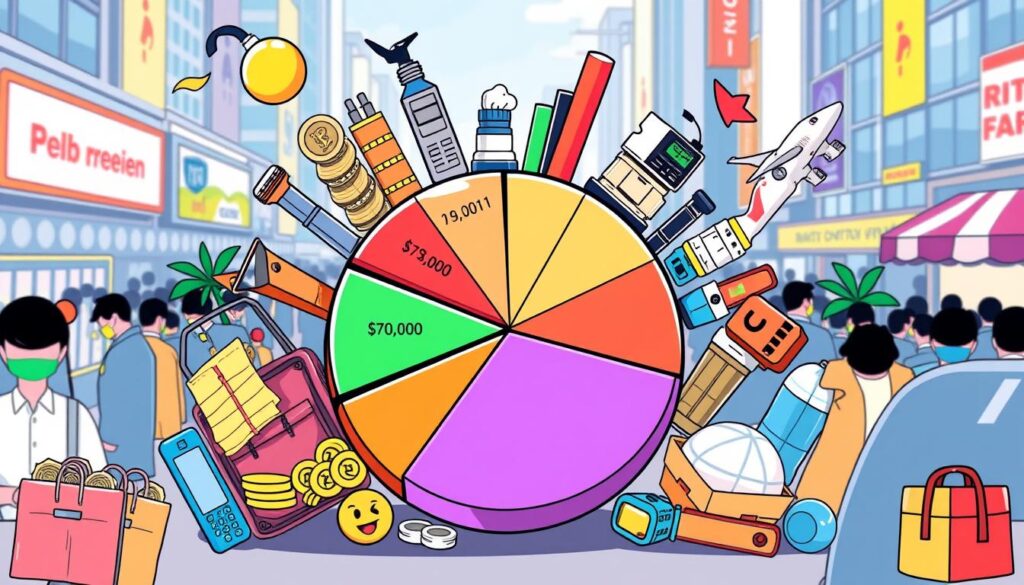How Lifestyle Inflation Quietly Eats Away at Your Finances

What if small changes in how you spend money secretly harm your financial goals? Lifestyle inflation can have a big impact on your finances. It’s key to know the hidden costs it brings. Looking back, I see how lifestyle inflation sneaks into our budgets, affecting our long-term money health.

Lifestyle inflation is often ignored, but it’s vital to see how small changes can hurt our financial stability. By understanding the risks of lifestyle inflation, we can start to protect our money and future.
Key Takeaways
- Lifestyle inflation can have a significant financial impact on your life
- Small changes in spending habits can add up over time
- Hidden costs associated with lifestyle inflation can be difficult to detect
- Understanding lifestyle inflation is crucial for maintaining financial stability
- Recognizing the risks of lifestyle inflation can help you secure your financial future
Understanding Lifestyle Inflation: My Personal Wake-up Call
Looking back, my journey with lifestyle inflation began with small changes that grew into big costs. I wanted to keep up with others, leading to spending on things I didn’t need. My desire to stay current with trends and tech blinded me to the financial harm.
Lifestyle inflation sneaks up on us, slowly increasing our spending as our income grows. Overspending is a big part of this, as we often treat ourselves to luxury items or experiences. It’s a silent threat to our finances.
Here are some small upgrades that can lead to big expenses:
- Upgrading to a newer car model every few years
- Moving to a larger house or apartment
- Increasing dining out or entertainment expenses
- Subscribing to premium services or products
By sharing my story, I hope to warn others about lifestyle inflation. It’s crucial to watch our spending and avoid this trap. By being mindful, we can prevent lifestyle inflation and secure a better financial future.
| Category | Initial Expense | Monthly Expense |
|---|---|---|
| Housing | $10,000 | $500 |
| Transportation | $5,000 | $200 |
| Entertainment | $1,000 | $100 |
The Hidden Costs of Lifestyle Inflation: How Small Changes Impact Long-Term
Exploring my finances, I found out about the hidden costs of lifestyle inflation. Small changes, like more expensive housing or subscriptions, can add up. For example, a $50 monthly increase in housing costs might seem small. But it adds up to $600 a year, which could go towards savings or paying off debt.
It’s vital to understand how lifestyle inflation affects saving, debt, and reaching financial goals. By knowing these hidden costs, people can make better spending choices. This helps in planning for the future. Key points to consider include:
- Assessing subscription services and canceling unused ones
- Reviewing housing costs and exploring cost-effective alternatives
- Creating a budget that accounts for small changes and their long-term impact
By managing these small changes, people can fight lifestyle inflation. This helps them move closer to their financial goals. As shown in the table below, even small increases can have a big impact over time:
| Monthly Increase | Yearly Impact | 5-Year Impact |
|---|---|---|
| $50 | $600 | $3,000 |
| $100 | $1,200 | $6,000 |
| $200 | $2,400 | $12,000 |
The Sneaky Ways Lifestyle Inflation Crept Into My Budget
Looking at my budget, I saw how lifestyle inflation had quietly drained my money. It began with small upgrades and spread to different parts of my spending.
Housing and Utility Creep
My housing costs went up when I moved to a bigger apartment. My utility bills also increased. This change in my budget was a sign of lifestyle inflation. It showed me the need to watch my spending closely.
Transportation Expenses
Buying a new car with fancy features raised my transportation costs. I also started using ride-hailing services more, adding to my expenses. These changes, though convenient, were part of lifestyle inflation.
Entertainment and Dining Habits
Dining out became a regular thing for me. I also subscribed to streaming services and went to events. These activities were fun but increased my entertainment costs, adding to lifestyle inflation.
Subscription Services
I had many subscription services, like music and software platforms. Even though each was cheap, the total cost was high. I needed to review my subscriptions to cut down on unnecessary spending.
To fight lifestyle inflation, it’s key to notice and adjust small changes in your budget. Being aware of your spending and making smart choices can help you stay on track financially.
| Category | Initial Cost | Current Cost |
|---|---|---|
| Housing | $1,000 | $1,200 |
| Transportation | $500 | $700 |
| Entertainment | $200 | $400 |
| Subscription Services | $50 | $100 |
Breaking Down My Monthly Spending Changes
Looking into my finances, I saw how crucial it is to know where my money goes each month. I started tracking my spending and found ways to cut costs. One big change was stopping unnecessary subscriptions, which really helped lower my monthly bills.
Some key budget tweaks I made include:
- Reducing dining out and cooking at home more often
- Cancelling subscription services I didn’t use regularly
- Implementing a more efficient financial tracking system
These small tweaks have made a big difference over time. They’ve helped improve my financial health.
By keeping an eye on my spending and making smart budget choices, I’ve made my finances better. This has helped me use my money more wisely and move closer to my financial goals.

This journey taught me the importance of regularly checking my budget and making changes when needed. It’s helped me stay on top of my finances and move closer to my financial goals.
| Category | Original Monthly Spending | Revised Monthly Spending |
|---|---|---|
| Subscription Services | $100 | $20 |
| Dining Out | $500 | $200 |
| Entertainment | $300 | $150 |
The Psychology Behind Lifestyle Inflation
Understanding why we spend more as we earn more is key to stopping emotional spending. Often, we want to keep up with others, not because we need to. Social media shows us the best parts of others’ lives, fueling this desire.
Studies show we compare ourselves to those who seem better off. This makes us unhappy with our lives. We then spend more to match what we think others have. Sites like Instagram and Facebook make it easy to feel left out by showing only the highlights.
Why We Feel Compelled to Upgrade
We feel like we’re missing out (FOMO) when we see others enjoying luxuries. This fear makes us buy things on impulse. These quick buys can quickly add up, leading to lifestyle inflation.
The Role of Social Media
Social media fuels lifestyle inflation by making us feel like we must keep up. It shows us things we can’t afford, making us want them more. Algorithms on these platforms aim to keep us engaged, often with expensive items.
Breaking the Emotional Spending Cycle
To stop emotional spending, we must understand what drives it. Being aware of our emotions and social media’s impact helps us make better choices. This means taking a break from social media, being grateful, and focusing on what truly makes us happy.
- Practice self-reflection to understand your emotional spending triggers
- Set clear financial goals and priorities
- Use the 30-day rule to delay impulse purchases
My Strategy for Combating Lifestyle Creep
To fight lifestyle inflation, I created a strategy. It involves tracking my spending and making a financial planning plan. This helps me spot where I can cut costs and reach my financial targets.
Here are the main steps I took:
- Watching my daily spending to see where it goes
- Setting up a budget for all my essential costs
- Putting aside some of my income for savings and investments
By using this strategy and sticking to my financial planning goals, I’ve fought off lifestyle inflation. Combating lifestyle inflation needs discipline and patience. But with the right plan, you can reach financial stability and security.

Remember, financial planning is an ongoing task that needs regular checks and tweaks. By staying true to my goals and watching my spending, I keep my finances in check. This helps me avoid the dangers of lifestyle inflation.
Creating a Sustainable Lifestyle Without Sacrifice
To live sustainably, finding balance in spending is key. It’s about making smart choices on how to use resources. We should focus on what we need over what we want and think about the environment and our money.
Choosing quality over quantity is important when buying things. Spending more on items that last longer can save money in the long run. It also helps reduce waste and supports sustainable living.
Developing good financial habits is crucial for a sustainable lifestyle. This means setting achievable financial goals, making a budget, and keeping track of spending. These steps help us reach our financial goals without feeling limited.
Some key strategies for building lasting financial habits include:
- Setting clear financial goals
- Creating a budget that accounts for all expenses
- Tracking expenses to ensure alignment with financial goals
- Regularly reviewing and adjusting financial habits as needed
By focusing on balance, quality, and financial habits, we can reach our financial goals. We also help make the future more sustainable.
| Strategy | Benefits |
|---|---|
| Setting clear financial goals | Increased motivation and direction |
| Creating a budget | Improved financial management and reduced stress |
| Tracking expenses | Greater awareness of spending habits and areas for improvement |
Long-term Impact on Wealth Building
Thinking about my fight against lifestyle inflation, I see its big impact on building wealth. It affects not just my money now but also my future plans for retirement and investments.
It’s key to understand how lifestyle inflation works over time to make smart spending choices. By choosing needs over wants and skipping unnecessary buys, I can reach my financial dreams. The goal is to build wealth and see how small spending changes can add up big time.
Lifestyle inflation can harm my financial future in several ways:
- It delays retirement planning because money goes to lifestyle upgrades instead of savings.
- It means missing out on investment opportunities because I spend on luxuries instead of growing my wealth.
- It weakens the compound effect of savings because there’s less money to save and invest.
By keeping an eye on lifestyle inflation’s long-term effects, I can make choices that help my financial goals. This might mean looking for investment opportunities that fit my values and risk level. Or, I might explore new ways to plan for retirement that help me reach my goals.
Tools and Techniques I Use to Track Spending
To manage my finances, I use different budgeting tools and financial tracking methods. These tools help me see where my money goes and make smart spending choices. By tracking spending, I find ways to save and use my money better.
I make a monthly budget, watch my expenses, and set financial goals. I also use online tools to stay organized. For instance, a budgeting app helps me track my spending and stay within budget. It lets me sort my expenses, set budgets, and alerts me if I overspend.
I also track my investments with financial tracking software. It gives me real-time data and insights. This helps me make smart investment choices and adjust my strategy when needed.
Using these budgeting tools and financial tracking methods, I understand my finances well. This helps me reach my long-term goals. If you’re starting to track your spending or want to improve your budget, try different tools and techniques. Find what works best for you.
Conclusion: Taking Control of Your Financial Future
Lifestyle inflation can quietly harm your financial progress if not managed. But, by controlling your spending and setting long-term goals, you can build a lasting lifestyle. This way, you won’t have to give up on your dreams.
Stay alert to your expenses and keep checking your priorities. Make choices that help your financial future. Use the strategies and tools we’ve talked about to fight lifestyle creep. This will help you save for what’s important to you, like retirement or valuable experiences.
Your financial future is up to you. Start by looking at your spending and finding ways to improve. With discipline and a focus on the future, you can take back control of your finances. Begin your journey to a secure and fulfilling future today. Take charge of your financial destiny and live the life you’ve always wanted.
FAQ
What is lifestyle inflation?
Lifestyle inflation means spending more as your income grows. It’s when you upgrade your lifestyle with new money, instead of keeping spending the same.
How can small changes in spending habits lead to significant long-term financial impact?
Small spending changes, like buying a pricier home or car, can add up. They can hurt your ability to save and invest for the future. These costs can quietly harm your financial progress.
What are some of the sneaky ways lifestyle inflation can creep into my budget?
Lifestyle inflation can sneak into your budget in many ways. It includes higher costs for housing and utilities, more expensive transportation, and dining out more. It also includes more subscription services.
How can I break the emotional spending cycle caused by lifestyle inflation?
To stop emotional spending, understand why you want to upgrade your lifestyle. Reduce social media’s influence and find a balance in spending. This helps you make better financial choices.
What tools and techniques can I use to track my spending and combat lifestyle inflation?
Use budgeting tools and financial tracking methods to keep an eye on spending. Apps, spreadsheets, or even a simple notebook can help. The goal is to regularly check your spending and find ways to adjust your lifestyle.




